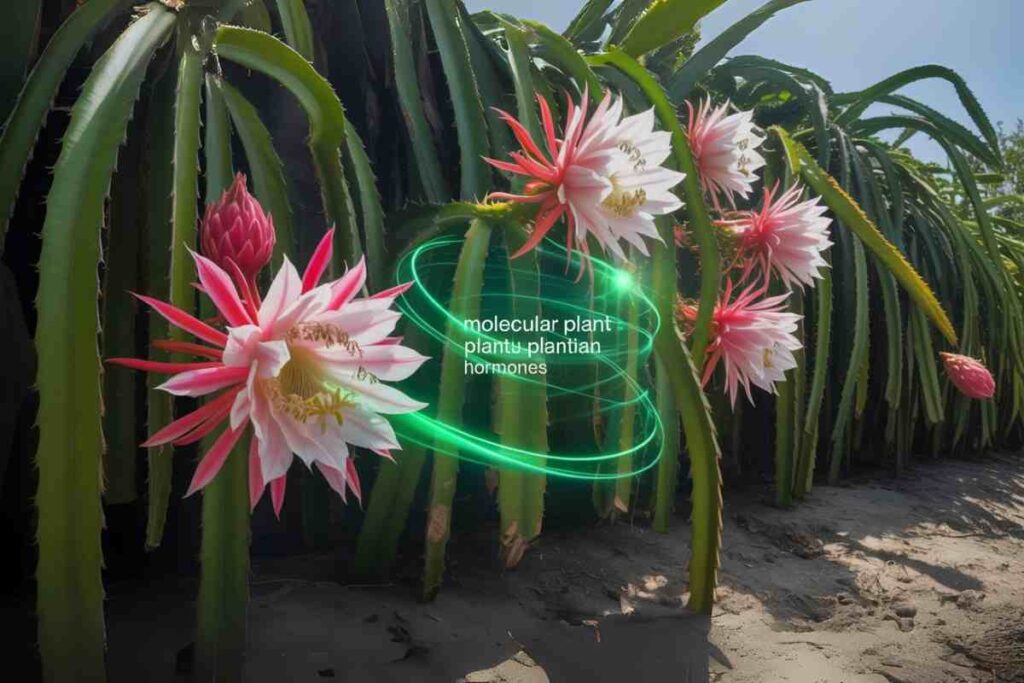If you are looking to boost flowering in high value crops like pitahaya or enhance the overall health of your plants, Inkacito offers a scientifically backed solution. Combining plant hormones and natural seaweed extracts, this biofertilizer helps accelerate floral bud formation, improve stress tolerance, and support consistent yields.
Understanding Inkacito: How It Boosts Flowering Naturally
Inkacito is a biofertilizer specially formulated to enhance flowering and improve crop productivity. Its effectiveness comes from a dual action combination of cytokinins, which are plant hormones that regulate cell division, stimulate lateral bud growth, and trigger flowering, and seaweed extracts that provide essential micronutrients, amino acids, and growth promoting compounds.
Together, these ingredients ensure that plants receive both the hormonal signals and the biochemical resources needed to respond effectively, promoting robust flower bud formation and healthier overall growth.
The Science Behind Inkacito
Cytokinins play a critical role in plant development by stimulating cell division, delaying leaf aging, and encouraging lateral branching. By applying them at key growth stages, Inkacito helps plants transition efficiently from vegetative to reproductive phases, ensuring timely flowering.
Seaweed extracts complement this hormonal effect by supplying vital nutrients and stress-resistance compounds. These extracts enhance protein synthesis, improve tolerance to drought and temperature fluctuations, and generally boost plant vigor. The synergy between cytokinins and seaweed extract makes Inkacito a practical solution for promoting flowering while supporting overall crop health.
How Inkacito Supports Different Crops
In pitahaya (dragon fruit) cultivation, synchronized flowering is essential for high-value fruit production. Farmers using Inkacito during the pre-flowering stage have reported quicker flower bud initiation, improved fruit set, and higher yields.
For rice cultivation, anecdotal evidence suggests that applying Inkacito can accelerate floral transitions, potentially shortening the reproductive phase and enhancing panicle development.
Inkacito’s versatility extends to other fruiting crops, including citrus orchards, mango and guava trees, and specialty berries, providing a reliable boost to flowering and overall crop performance.
Applying Inkacito for Maximum Effectiveness
Proper application is crucial to getting the best results from Inkacito. Farmers should apply the biofertilizer during pre-flowering or early flowering stages to ensure plants respond efficiently. Foliar spray is the most effective method for absorption, and following recommended concentrations helps avoid foliage damage or resource waste.
Practical Tip: Conduct small-scale trials before applying Inkacito widely. This allows you to fine-tune dosage based on your specific crop, soil type, and climate conditions.
Key application considerations include:
- Timing applications for the correct growth stage
- Observing plant response and adjusting if needed
- Integrating Inkacito with a balanced fertilization plan rather than using it as a replacement
Benefits of Using Inkacito
Inkacito offers multiple advantages for growers. By promoting synchronized bud formation, it ensures timely flowering and can lead to increased fruit set and higher yields. The seaweed extracts improve plants’ resilience against heat, drought, and nutrient stress, while the combined hormonal and nutritional support enhances overall plant vigor. For farmers, these benefits translate into more predictable flowering cycles, stronger crops, and potentially higher income from improved yields.
Limitations and Important Considerations
While Inkacito shows promise, users should be aware of certain limitations. Most available evidence is anecdotal, and peer-reviewed research remains limited. Results can vary depending on crop species, soil quality, climate, and farming practices. Farmers should also confirm that the product complies with local regulations for biostimulants and should consider it as a complement to traditional soil nutrition rather than a full replacement.
Practical Tips for Farmers
Successful Inkacito use relies on precise application and careful monitoring. Applying at the right growth stage, using accurate measurement tools, and keeping detailed records of flowering and yield outcomes can help refine future applications. Integrating Inkacito with other nutrient management strategies ensures plants receive a holistic approach to growth and flowering.
Real-World Example
A small pitahaya farm in Mexico trialed Inkacito on 100 plants by applying it during the pre-flowering stage. The result was a 30% faster flower bud initiation compared to untreated plants, along with a 15% increase in overall fruit yield per plant. This demonstrates how targeted and well-monitored application can significantly improve crop productivity and flowering success.
Frequently Asked Questions
Which crops benefit most from this biofertilizer?
It works well with flowering and fruiting crops such as pitahaya, rice, citrus, mango, guava, and other similar plants.
How does it help plants flower more effectively?
The formula supports natural plant hormones and provides nutrients from seaweed, helping buds develop more reliably and flowers appear on schedule.
When is the best time to apply it?
Early in the flowering stage or just before buds appear is ideal for optimal results.
Is it safe for all plants?
Generally yes, but using too much can harm leaves. It’s best to follow the recommended dosage and try it on a small number of plants first.
Can it replace regular fertilizers?
No, it should be used alongside a balanced fertilization program to support overall plant health rather than as a replacement.
Conclusion
This biofertilizer offers a practical way to encourage flowering, support plant growth, and improve crop performance. While much of the evidence comes from field observations rather than formal studies, careful use and small-scale trials can help gardeners and farmers see noticeable results.
Starting with a limited application and monitoring how plants respond allows you to adjust for the best outcome. Used thoughtfully, it can be an effective addition to a broader plant care routine, helping ensure healthier plants and more consistent flowering.





